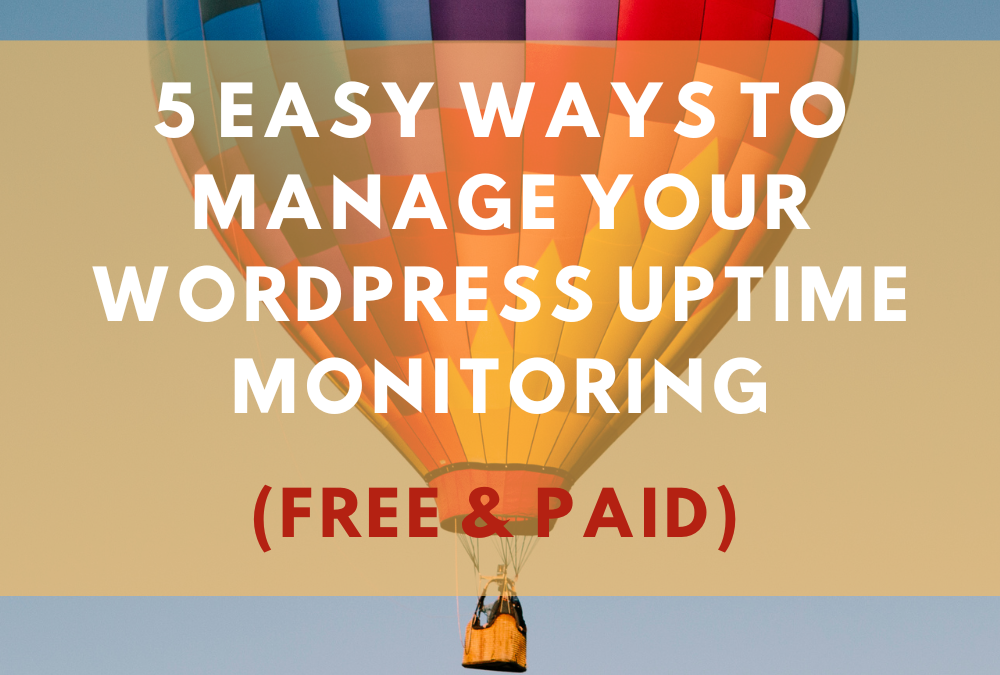Table of Contents
Would you like to keep track of the server uptime for your WordPress site? Monitoring server uptime allows you to receive alerts when your website goes down or becomes unavailable.
Keeping your website online guarantees that your visitors have no problems browsing it. Unresponsive websites are not only awful for user experience, but they can also harm SEO rankings. We have personally experienced that here at Free Range Entrepreneur following a period of site downtime!
We’ll teach you how to simply check server uptime in WordPress in this article. We’ll provide some uptime monitoring options, and you can select the one that works best for you.
What is WordPress Uptime Monitoring & Website Server Uptime?
Monitoring website server uptime helps you to track failures on your website. If something goes wrong with your website, the server uptime monitoring tools will tell you quickly so that you can correct it.
Many WordPress hosting companies guarantee 99.9% server uptime. However while the best will provide this level of service, this is not always the case with all hosting companies.
The most obvious symptom of a substandard hosting service is that their servers regularly go down and remain down for many minutes or even hours at a time.
Why Is It Necessary to Monitor Server Uptime?
Users frequently place their faith in their web hosting businesses and let their guard down. You may not even realise your website was down, especially if it occurred in the middle of the night or over a holiday.
Downtime on your website can have a negative impact on your business, website reputation, and user experience.
- More downtime means more money lost. If your website is unavailable for an extended length of time, you may suffer loss of income from outbound links, advertising, or product sales.
- User Experience and Brand Image. Having your website offline is like purposely closing your door in the faces of your customers. It gives a negative image and may cause you to lose potential consumers.
- Search Engine Influence. If your website is regularly down, search engines may conclude that it is unimportant or inconsistent. They frequently punish websites that fail to maintain continuous uptime.
Obviously, it’s not feasible to simply sit in front of a computer and continuously refresh it to see if it is operational.
However you can use several pretty good and free programmes to automatically check server uptime for your website.
Broadly speaking these services fall into the category of either third party monitoring sites or WordPress plugins. These services will monitor your site’s uptime and notify you through email or SMS message if your server goes down.
Let’s have a look at some of these tools for checking your website’s server uptime.
1. Uptime Robot to track server uptime.
Uptime Robot provides both free and commercial options to monitor the uptime of your server and there is a dashboard widget available for WordPress (although not necessary for monitoring).
Their free plan scans your website every 5 minutes, while their subscription plan scans it every 60 seconds. The paid subscription begins at $7 per month (billed yearly) and includes SMS, voice calls, email, and other notifications.
The first step is to go to the Uptime Robot website and click the Signup button.
Following that, you must choose a monitoring service plan (free or pro).
Finish the registration procedure by logging in to your Uptime Robot account dashboard. From here, you must select the “Add New Monitor” option.
This will open a box where you can choose a monitoring method (HTTP or HTTPS) and enter your website URL. You can also set up notifications to be delivered when your website is unavailable in the same page.
When finished, click the ‘Create Monitor’ button to confirm your changes.
Uptime Robot will now remember your website and begin monitoring the uptime of your server. On your account dashboard, you’ll be able to view detailed statistics and receive notifications when your website is unavailable.
2. Pingdom for Uptime Monitoring
Pingdom is a popular performance monitoring application that allows you to check your website’s server uptime. Pingdom is a subscription service with monthly options beginning at $15 and a free trial to get you started.
Pingdom is a more comprehensive platform that provides real-time uptime monitoring. They provide thorough statistics, logs, monitoring from multiple geographic regions, and other services.
To begin your free trial, go to the Pingdom website and click on the green button.
To establish an account, you must specify your email address and a password. Following that, you will be asked to submit your phone number, email address, time zone, and website URL. Check the performance and monitoring choices before clicking the ‘Let’s get started’ button.
Pingdom will set up monitoring immediately and send you a test alert to your email address. That’s all; you’ve successfully set up Pingdom uptime monitoring for your website.
You may configure several notifications and tracking for different places. Pingdom documentation and support can assist you with this, although their interface is quite simple.
Pingdom also saves your uptime history, allowing you to fully analyse the performance of your web hosting business over time.
3. Manually Verifying Your Website Is Up or Down
If you only want to know if your website is down or if you have internet problems, you can do it easily using IsItWP’s uptime checking application.
Simply type your website address into the IsItWP Uptime Checker tool.
The Uptime Checker tool can rapidly check your website and inform you whether it is up or down.
4. Monitor with Jetpack Plugin
Jetpack enhances the functionality and administration of your WordPress website. Jetpack’s key characteristics include protection against brute-force attacks, spam filtering, and downtime monitoring.
The Jetpack plugin contains the Monitor module. When enabled, this feature will check the site every five minutes.
Monitor will send you an email notification as soon as the site is no longer available. This is one of the simplest and most fundamental strategies for monitoring WordPress uptime.
5. Using a Content Delivery Network (CDN)
One of the simplest methods to keep your site up and running is to use a content delivery network, such as CloudFlare. It basically spreads a webpage across many servers.
According to data, several of these CDN providers can provide near-perfect uptime. A CDN will distribute the site’s content to neighbouring servers of individuals who visit your website.
This dramatically improves uptime because failures on one server may not affect the accessibility of another.
What Should You Do If Your Website Is Down?
If your website is down and you’re not sure what to do next, here are the recommendations you should follow.
Step 1: Make sure it’s down for everyone, not just you.
You can begin by verifying your site’s uptime with IsItWP’s uptime checker. If it displays that your website is operational, it is most likely due to a problem with your internet connection.
Clear your browser’s cache and DNS cache first. Reload the webpage after that.
If it doesn’t work, try accessing your website from a different IP address. You may accomplish this by utilising a VPN service or even your mobile phone’s internet.
If you can access your website, it signifies that your ISP or hosting business has mistakenly restricted your IP address. To remedy the issue, you can contact both service providers.
If you have modified the DNS settings for your domain name, it is possible that the DNS has not been updated in your specific geographic region.
There isn’t much you can do except wait for DNS to be correctly updated. This might take anything from a few hours to a day.
Step 2: If Your Website Is Inaccessible to Everyone
If you’ve confirmed that your website is unavailable to everyone, you should contact your hosting provider right away. They may be experiencing server troubles and may give you further information.
Usually, hosting companies respond quickly to such situations, and your website will be up and running again soon.
However, if your website is regularly down or you do not receive a sufficient response from them, move on to the next stage.
Step 3: Switch to a Better Hosting Company
Because of the fierce rivalry in the hosting market, several lesser-known companies minimise costs by utilising old technologies, untrained employees, and poor customer service.
However, if your website is constantly down and you can’t fix it, you should switch to a better hosting company.
Here is our list of trustworthy (and green) WordPress hosting companies:
See our list of the top WordPress hosting companies for additional hosting alternatives.
Read:
- The 6 Best Value Green WordPress Hosting Providers
- Is Siteground Any Good? 10 Top Reasons to Switch Your Blog Hosting
The next step is to move your website to a different host.
Some hosting companies, such as Siteground will provide free website migration services. You only need to ask for their assistance.
Conclusion
If you rely on your website for generating income, then it is business critical. The website must be accessible and functional at all times of the day. When people are unable to access your website, you may be missing out on a large number of potential purchases and leads.
Take the required measures to ensure that your site is always active. While attaining a 100% uptime ratio might be tough, spotting problems early on can save you a lot of lost traffic.
We hope this post was useful in teaching you how to monitor server uptime in WordPress.
If you like this post, please subscribe to our Newsletter or find us on Twitter and Facebook.


Recent Comments